


This vault starts with a roundoff. The gymnast should execute a standard hurdle with them raising their arms up and opening their shoulder angle. There must be a strong kick from the back leg, and an effective snapdown by pushing on the floor. The roundoff should finish in a hollow body position, with tight legs. The gymnast’s head should be slightly down with their arms at horizontal. This will allow them to be ready for a strong kick back. The next move is the back handspring with a half turn during the first phase of the skill. The gymnast should perform the half turn before reaching handstand on the table. The gymnast should turn from their hip, and at the same time they should execute a strong back kick from their arms. They should block the table while they’re in handstand (no later than this). Next follows a regular front handspring. The difference between the Yurchenko vault and this vault is the half turn. Emphasize on the half turn from the hip (center of gravity), and a strong kick from the heels.

The vault starts with a roundoff. The gymnast should execute a standard hurdle, raising their arms up and opening their shoulder angle. They should perform a strong kick from the back leg, and then push off the floor with their lunge leg. A the last moment, the gymnast should place their first hand sideways on the floor. In the handstand position the legs should already be together. At this point the gymnast should turn another ¼ and place their second hand on the floor. If performed properly, the gymnast should finish the half turn slightly before handstand in an extended, tight position. Next follows an effective snapdown with a push from the hands. The round off should finish in a hollow body position with the legs tight. The head should be slightly down with the arms at horizontal so they can be ready for a strong kick back. The next move is the back handspring. The gymnast’s body should transform into a tight arch. There must be a strong arm kick backwards. The gymnast’s head should be slightly open and follow the hands. The gymnast should reach the table slightly before handstand in an arched position. There are two methods for the blocking action. The first is a regular block, similar to how it would be performed on the floor - snapdown block. In this case the gymnast’s arms should push the surface downward. After that, the upper body should transform into a hollow. The second method is pushing opposite (upward). This technique is more convenient for high difficulty skills such as Yurchenko layout, with twists, etc. It helps the gymnast obtain a higher take-off. It’s suitable also for more experienced gymnasts who have developed a faster run. After the snapdown the gymnast should perform a back tuck before landing on the floor.

At the moment of the take-off, the gymnast should maintain a straight body with their hips slightly arched forward. Their arms should be raised at the level of their head. The twist should be led from the hip. The arm that is opposite from the direction of the twist should be bent and raised around shoulder height. The gymnast should begin to twist their body. The other arm should be bent too, but raised slightly higher so that it’s level with the gymnast’s head. The jump should be performed from the toes with tight legs.
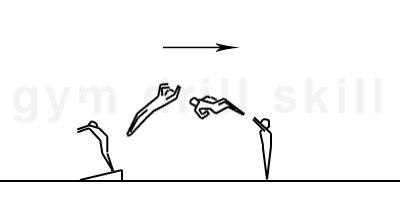
The gymnast should perform the arabian from a round-off onto a springboard. It’s recommended to do this drill into a foam pit.
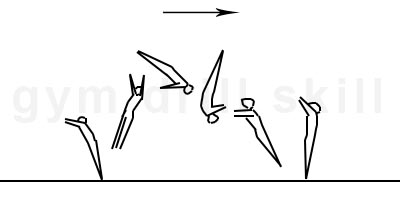
When the gymnast obtains enough experience and confidence with the arabian, they should perform it with tight legs. The gymnast can start working the skill on a trampoline, tumble track, or in a foam pit.
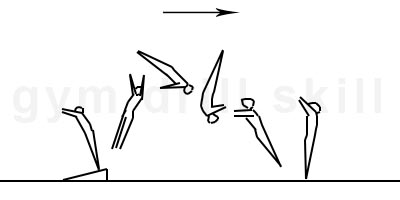
When the gymnast becomes comfortable performing an arabian with straight legs, they should move on to round-off on a springboard with the arabian being performed into a foam pit.

The gymnast should have significant amounts of experience performing a dive roll. It’s important for the gymnast to rebound from their hips, and position their arms properly during the twist. After the turn the gymnast should kick their heels backwards, turning their body into a slight arch. The landing is similar to a dive roll landing.
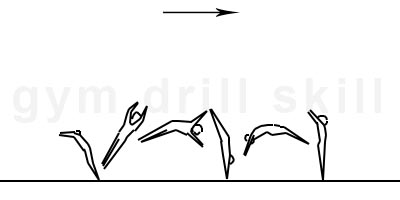
The gymnast should start learning this skill on a tumble track or a trampoline. They should perform the skill after a round-off or back handspring. The gymnast should jump backwards. If the jump is correct, the skill will be long. There should be an emphasis on turning at the moment of the rebound. After the twisting motion, the skill should lead from the heels. There should be a strong kick back from the heels. The second part of the drill is similar to the second part of the front handspring bounder. The gymnast should block downward. After the flight the gymnast should be in an arched position.

This skill is similar to the half turn bounder. The difference is that the gymnast shouldn’t touch the floor. Because of this, the gymnast should jump even higher at the beginning of the skill.
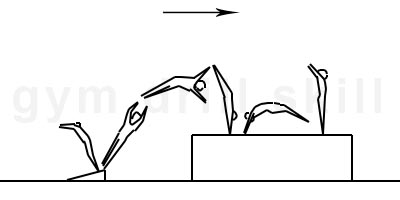
This is an intermediate drill. Before moving to the table, the gymnast should do a half turn bounder onto the resi mat. It’s already necessary for the gymnast to run longer and faster. The gymnast needs more speed for this drill because it requires them to finish on higher ground.
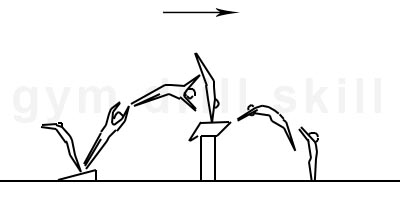
When the gymnast feels confident enough, the next step of the skill is to perform it into a foam pit.
Integral part of gymnastics coaching process are skill drills. They help gymnasts to learn easier and technically correct. With GYM DRILL PRO you will find variety of ideas for the most the basic gymnastics skills. There are plenty of images with skill drill progressions. It is intended to support explicitly the qualified coaches in their daily coaching business. DO NOT practice without the guidance of proper professionals.